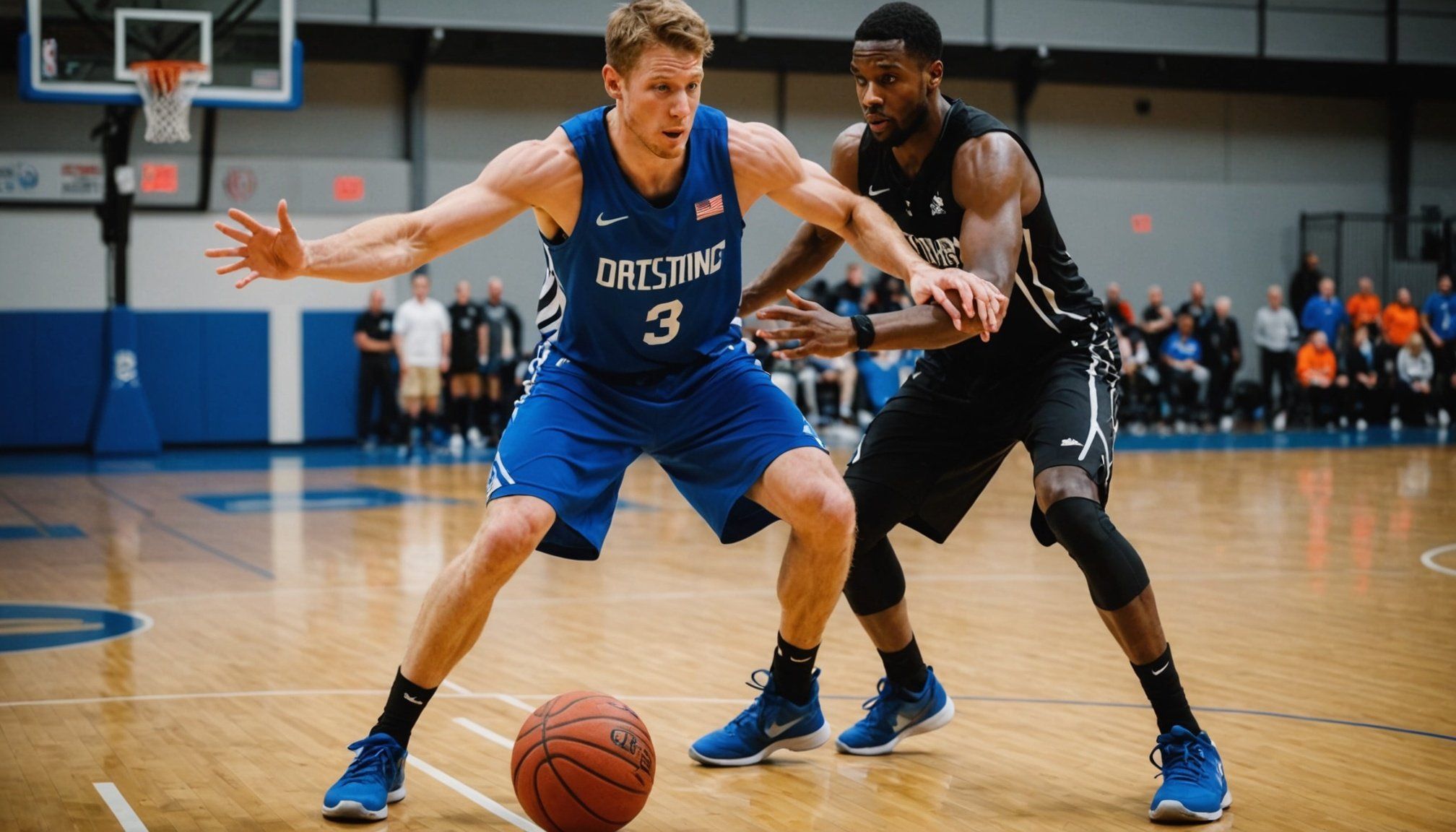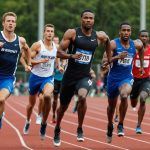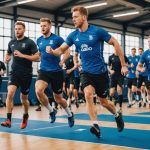Ultimate Guide to Injury Prevention: Top Cross-Training Strategies for UK Basketball Players
Understanding the Risks of Sports Injuries in Basketball
Basketball, like many other high-intensity sports, comes with a significant risk of injuries. From ankle sprains and ACL injuries to overuse conditions such as tendonitis, the physical demands of the game can be daunting. For UK basketball players, understanding these risks is the first step towards effective injury prevention.
“Basketball is a high-impact sport with frequent high-speed movements, jumps, and quick changes of direction, which increases the risk of injuries,” notes a study published in Cureus[1]. This highlights the need for a comprehensive approach to injury prevention, one that goes beyond mere physical training.
Also read : Boosting agility: innovative techniques for uk basketball teams to improve players” lateral movement
Holistic Injury Prevention Approach
A holistic approach to injury prevention involves several key components:
Biomechanical Assessments
Biomechanical assessments are crucial for identifying movement patterns or inefficiencies that can increase the risk of injury. Tools such as motion capture systems and force plates can analyze running gait, landing mechanics, and other critical movements. For example, poor pelvic positioning during dynamic activities can compromise stability and elevate the risk of strains or tears[1].
In the same genre : Ultimate guide to shoulder rehab for uk basketball athletes: boost recovery and strength with these essential exercises
Examples of Biomechanical Assessments:
- Motion Capture Systems: These systems track the movement of athletes in 3D, providing detailed insights into their biomechanics.
- Force Plates: These devices measure the ground reaction forces during jumps and landings, helping to identify potential issues with landing mechanics.
- Video Analysis: High-speed cameras can capture and analyze the movements of athletes, allowing coaches and trainers to correct any biomechanical inefficiencies.
Workload Management
Effective workload management is vital for preventing overuse injuries. Overtraining, characterized by excessive physical stress without adequate recovery, is a known risk factor for injury. Wearable technologies such as GPS trackers and heart rate monitors can help balance training loads and recovery periods.
Tools for Workload Management:
- GPS Trackers: These devices monitor the distance, speed, and intensity of training sessions.
- Heart Rate Monitors: These track the physiological response to training, helping to ensure that athletes are not overexerting themselves.
- Periodized Training Programs: These programs structure training into specific phases, ensuring that athletes have adequate recovery time between intense training periods.
Tailored Conditioning Programs
Tailored conditioning programs enhance muscular resilience and adapt to the specific demands of basketball. Programs like the Federation of International Basketball Association (FIBA) equivalent of the FIFA 11+ program incorporate strength, balance, and agility exercises designed to reduce the incidence of injuries.
Examples of Tailored Conditioning Programs:
- Plyometric Exercises: These exercises mimic the explosive movements common in basketball, such as jump squats and box jumps.
- Agility Drills: Drills that focus on quick changes of direction, such as zig-zag runs and shuttle runs, improve agility and reduce the risk of ankle sprains.
- Strength Training: Targeted strength training, particularly for the core, legs, and glutes, enhances overall stability and resilience.
Cross-Training Strategies for Basketball Players
Cross-training involves incorporating exercises and activities from other sports to enhance overall fitness and reduce the risk of injury. Here are some effective cross-training strategies for basketball players:
Rugby-Inspired Training
Rugby, another high-intensity contact sport, offers valuable training insights for basketball players. Rugby training often includes strength and conditioning exercises that can be beneficial for basketball.
Rugby-Inspired Exercises:
- Scrummaging Drills: These drills improve strength, power, and coordination.
- Tackling Techniques: Modified tackling drills can enhance agility and reaction time.
- Conditioning Games: Games like touch rugby can improve cardiovascular fitness and teamwork skills.
Football (Soccer) Conditioning
Football conditioning programs, such as the FIFA 11+ program, are highly effective in reducing injury rates. These programs can be adapted for basketball players to improve their overall fitness and resilience.
Football Conditioning Exercises:
- High-Intensity Interval Training (HIIT): This involves short bursts of high-intensity exercise followed by brief periods of rest.
- Agility Ladder Drills: These drills improve speed, agility, and quickness.
- Strength Training: Exercises like squats, lunges, and deadlifts strengthen the muscles used in both football and basketball.
Neuromuscular Training
Neuromuscular training is a critical component of injury prevention. It focuses on improving coordination, balance, and overall neuromuscular control.
Examples of Neuromuscular Training:
- Balance Exercises: Single-leg squats, balance boards, and BOSU ball training improve balance and stability.
- Plyometric Exercises: Jump squats, box jumps, and depth jumps enhance explosive power and neuromuscular coordination.
- Agility Drills: Zig-zag runs, shuttle runs, and cone drills improve quick changes of direction and reaction time.
Gradual Return-to-Play Protocols
When an athlete is returning from an injury, a gradual and structured return-to-play protocol is essential to minimize the risk of reinjury. The “Control to Chaos” continuum is a useful framework for this process.
Steps in the “Control to Chaos” Continuum:
- Controlled Rehabilitation: Initial rehabilitation exercises that are controlled and predictable.
- Progressive Loading: Gradually increasing the intensity and complexity of exercises.
- Sport-Specific Training: Training that mimics the specific demands of basketball.
- Full Competition: The final stage where athletes are fully integrated back into competitive play.
Nutrition and Recovery
Proper nutrition and recovery strategies are often overlooked but are crucial for injury prevention.
Key Nutritional Components:
- Hydration: Proper hydration maintains joint lubrication, muscle elasticity, and neuromuscular coordination[1].
- Antioxidants: Vitamins C and E protect muscle tissue from oxidative stress, reducing soreness and enhancing recovery[1].
- Post-Exercise Nutrition: Consuming carbohydrates and proteins within 30 minutes after exercise replenishes glycogen stores and supports muscle repair[1].
Technology in Injury Prevention
Advanced technologies play a significant role in modern injury prevention strategies.
VOGO’s Audio and Video Solutions:
- VOGOSCOPE STAFF: A video capture and broadcasting solution that allows medical teams to analyze training sessions and competitions to identify potential injury risks[2].
- VOKKERO STAFF: An intercom system that enhances communication between medical team members during loud events[2].
- VOGO STAFF BUNDLE: A comprehensive system combining audio and video solutions for decision-making and analysis[2].
Practical Insights and Actionable Advice
Here are some practical tips for UK basketball players to integrate into their training programs:
Biomechanical Assessments:
- Regularly undergo biomechanical assessments to identify and correct any movement inefficiencies.
- Use video analysis to review and improve your technique.
Workload Management:
- Use GPS trackers and heart rate monitors to monitor your training loads and ensure adequate recovery.
- Implement periodized training programs to avoid overtraining.
Tailored Conditioning Programs:
- Incorporate plyometric exercises, agility drills, and strength training into your conditioning program.
- Adapt programs like the FIFA 11+ to your basketball training.
Cross-Training:
- Incorporate rugby-inspired training for strength and conditioning.
- Use football conditioning programs to improve overall fitness and resilience.
Neuromuscular Training:
- Include balance exercises, plyometric exercises, and agility drills in your training.
- Focus on improving coordination, balance, and overall neuromuscular control.
Gradual Return-to-Play:
- Follow the “Control to Chaos” continuum when returning from an injury.
- Ensure a structured and progressive approach to rehabilitation.
Nutrition and Recovery:
- Maintain proper hydration and consume antioxidants to support recovery.
- Ensure post-exercise nutrition includes carbohydrates and proteins to replenish glycogen stores and support muscle repair.
By adopting these strategies, UK basketball players can significantly reduce their risk of injury and enhance their overall performance.
Injury prevention in basketball is a multifaceted challenge that requires a holistic approach. By combining biomechanical assessments, workload management, tailored conditioning programs, cross-training strategies, neuromuscular training, and a focus on nutrition and recovery, athletes can minimize their risk of injury and optimize their performance. Leveraging advanced technologies and following structured return-to-play protocols further enhance these efforts. With the right strategies and tools, UK basketball players can stay healthy, perform at their best, and enjoy a long and successful career in the sport.
Table: Comparison of Cross-Training Strategies
| Cross-Training Strategy | Examples of Exercises | Benefits | Sports |
|---|---|---|---|
| Rugby-Inspired Training | Scrummaging drills, tackling techniques, conditioning games | Strength, power, coordination | Rugby, Basketball |
| Football Conditioning | HIIT, agility ladder drills, strength training | Cardiovascular fitness, agility, strength | Football, Basketball |
| Neuromuscular Training | Balance exercises, plyometric exercises, agility drills | Coordination, balance, neuromuscular control | Various sports |
| Biomechanical Assessments | Motion capture systems, force plates, video analysis | Identify movement inefficiencies, improve technique | Various sports |
| Workload Management | GPS trackers, heart rate monitors, periodized training programs | Prevent overtraining, ensure adequate recovery | Various sports |
Detailed Bullet Point List: Key Components of a Holistic Injury Prevention Approach
-
Biomechanical Assessments:
-
Use motion capture systems to analyze running gait and other movements.
-
Employ force plates to assess landing mechanics.
-
Conduct video analysis to identify biomechanical inefficiencies.
-
Implement corrective measures such as neuromuscular training and targeted strength conditioning.
-
Workload Management:
-
Use GPS trackers to monitor training distances and intensities.
-
Utilize heart rate monitors to track physiological responses to training.
-
Implement periodized training programs to balance training loads and recovery periods.
-
Reduce high-speed running efforts during intense training phases.
-
Tailored Conditioning Programs:
-
Incorporate strength, balance, and agility exercises.
-
Adapt programs like the FIFA 11+ for basketball-specific demands.
-
Include plyometric exercises to mimic explosive movements.
-
Focus on sport-specific demands, such as shoulder stabilization routines for swimmers.
-
Cross-Training Strategies:
-
Incorporate rugby-inspired training for strength and conditioning.
-
Use football conditioning programs to improve overall fitness and resilience.
-
Engage in neuromuscular training to improve coordination and balance.
-
Gradual Return-to-Play Protocols:
-
Follow the “Control to Chaos” continuum.
-
Start with controlled rehabilitation exercises.
-
Progress to sport-specific training.
-
Gradually integrate athletes back into full competition.
-
Nutrition and Recovery:
-
Maintain proper hydration to support joint lubrication and muscle elasticity.
-
Consume antioxidants to reduce oxidative stress and enhance recovery.
-
Ensure post-exercise nutrition includes carbohydrates and proteins to replenish glycogen stores and support muscle repair.
-
Use anti-inflammatory nutrients like turmeric and ginger to support connective tissue health.











